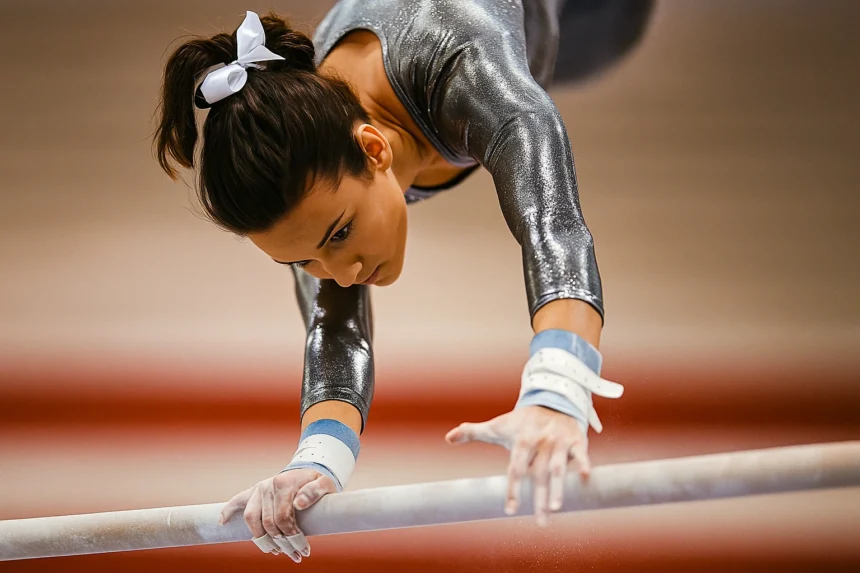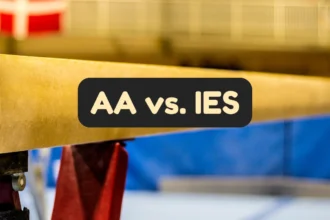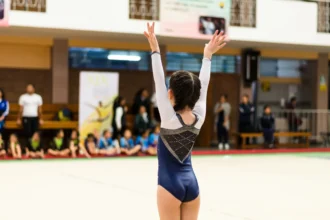Becoming an elite gymnast means entering a highly selective track where you compete nationally and internationally under the strict standards of USA Gymnastics (USAG) and the International Gymnastics Federation (FIG).
- Step 1: Begin with the Developmental / Junior Olympic Pathway
- Step 2: Enter the Talent Pipeline – TOPs and HOPEs Programs
- Step 3: Pass the Elite Compulsory Qualifier
- Step 4: Meet the Optional Qualifying Score
- Step 5: Compete in Elite Meets (American & U.S. Classics)
- Step 6: Advance to the U.S. Championships
- Step 7: Transition from Junior Elite to Senior Elite
- Step 8: Maintain Scores and National Ranking
- 2025 Elite Qualification Scores (USA Gymnastics)
- Key Takeaways
If your dream is to make that climb, here is how the qualification process works:
Step 1: Begin with the Developmental / Junior Olympic Pathway
Most gymnasts start in the Development Program (formerly known as the Junior Olympic, or JO, system).
- Levels 1–2: Introductory developmental stages, focusing on basics and building body awareness.
- Compulsory Levels 3–5: Standardized routines designed to teach fundamentals across all four women’s events (vault, uneven bars, beam, floor) or six men’s events in MAG.
- Optional Levels 6–10: Athletes perform individualized routines that include specific skill requirements.
Level 10 is the highest developmental level and is open to girls as young as 9 years old. Level 10 gymnasts compete at state, regional, and national championships, with JO Nationals serving as the pinnacle event. Many athletes who eventually qualify as elites come from this pool of experienced Level 10 competitors.
Step 2: Enter the Talent Pipeline – TOPs and HOPEs Programs
Elite gymnastics in the U.S. doesn’t happen by accident—it’s supported by programs that identify and nurture potential early.
- Talent Opportunity Program (TOPs):
Targets gymnasts ages 7–10. Athletes are evaluated through physical abilities and skills testing at the state and national level. The top scorers attend training camps at the National Team Training Center, where they learn advanced skills under elite coaches. - HOPEs (Olympic Hopefuls):
Designed for gymnasts ages 11–14. HOPEs bridges the gap between Level 10 and Junior Elite. To qualify, gymnasts must pass both compulsory and optional elite qualifiers with a minimum all-around score. Successful HOPEs athletes compete in their own division at elite meets like the U.S. Classic, but are not yet considered official junior elites.
Step 3: Pass the Elite Compulsory Qualifier
Every gymnast aspiring to elite status must begin with elite compulsory routines. These are different from the Development Program compulsory levels and are specifically designed to test fundamental strength, flexibility, and technique at an elite standard.
- Athletes must perform compulsory routines on each apparatus in front of judges at designated Elite Compulsory Qualifiers.
- They need to achieve a minimum compulsory score (set by USAG and updated annually) to move forward to the optional stage.
This step ensures only gymnasts with the technical foundation progress toward elite qualification.
Step 4: Meet the Optional Qualifying Score
Once the compulsory score is achieved, gymnasts attempt optional elite qualification. This involves performing personalized routines with advanced skills.
- Optional routines are evaluated at Elite Qualifiers or designated competitions.
- Gymnasts must reach a minimum optional all-around score (different for Junior and Senior divisions).
If the gymnast achieves this score, she becomes an elite qualifier and may enter higher-level meets such as the American Classic or U.S. Classic.
Step 5: Compete in Elite Meets (American & U.S. Classics)
Qualifying scores allow gymnasts to enter elite invitationals, where they must continue to prove consistency and difficulty.
- American Classic / U.S. Classic: These meets serve as the gateway to national championships. Gymnasts must again hit set all-around scores here to advance.
- Performing well at these events is critical—it shows readiness to compete alongside the nation’s best.
Step 6: Advance to the U.S. Championships
With success at the Classics, gymnasts earn a spot at the U.S. Championships, where they compete against the top elites in the country.
- Strong results here can earn an athlete national team status, invitations to training camps, and consideration for international assignments.
- The U.S. Championships also serve as a stepping stone toward World Championships, Pan American Games, and the Olympic Games.
Step 7: Transition from Junior Elite to Senior Elite
Age is a defining factor in elite gymnastics.
- Junior Elite: Ages 11–15. These gymnasts compete at national and some international meets but are not yet eligible for the Olympics or Worlds.
- Senior Elite: Age 16+. Only senior elites are eligible for major international competitions, including the Olympic Games.
This transition marks the moment when gymnasts move from being promising athletes to potential Olympians.
Step 8: Maintain Scores and National Ranking
Qualifying once isn’t enough, elite status must be re-earned annually. Gymnasts are expected to:
- Compete in designated qualifiers each season.
- Achieve updated compulsory and optional scores.
- Maintain performance standards to remain eligible for elite competitions.
This ongoing requirement ensures that only athletes at peak performance levels retain elite status.
2025 Elite Qualification Scores (USA Gymnastics)
| Category | Compulsory Score Requirement | Optional Score Requirement |
|---|---|---|
| New International Elite (Compulsory) | All Events: 35.00 2 Events: 17.50 3 Events: 26.25 | — |
| Senior Elite – General Qualification | — | AA: 50.00 3 Events: 39.30 2 Events: 26.60 |
| Senior Elite – To U.S. Championships | — | AA: 52.00 3 Events: 39.60 2 Events: 26.80 |
| Junior Elite | — | AA: 49.00 |
| HOPEs Division (reference, prior years) | ~35.00 | ~45.00 (AA) |
Key Takeaways
- The elite path is a long, multi-stage process, beginning in the Development Program.
- Success in TOPs and HOPEs helps, but isn’t mandatory.
- Gymnasts must pass both Elite Compulsory and Optional Qualifiers to enter the elite level.
- Elites are divided into Junior (11–15) and Senior (16+) divisions.
- Advancement requires strong performances at national competitions and consistency over time.
- Making the National Team is the gateway to Worlds and Olympics.












